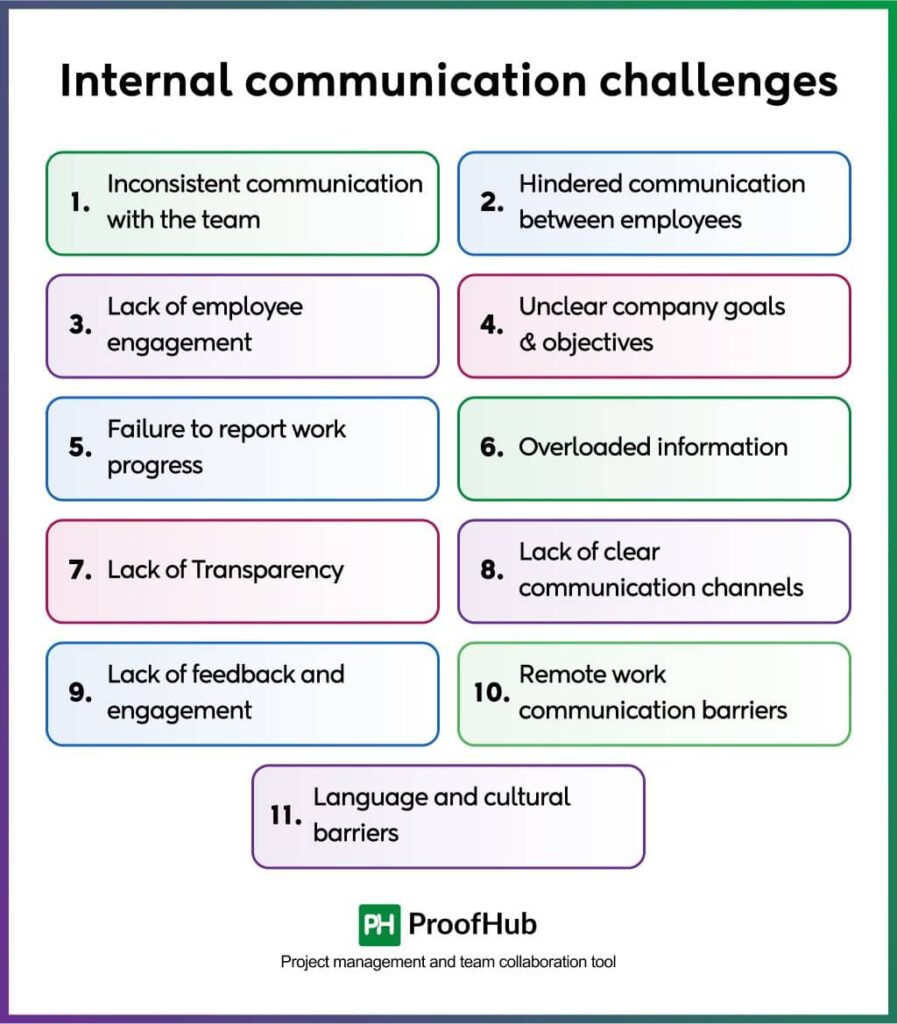Introduction
As a leader, did you ever struggle to keep your team in sync?
Do you often repeat instructions & expectations to your employees?
Do you constantly miss deadlines due to communication breakdowns?
These are just some of the internal communication challenges that leaders often face.
Effective internal communication is a foundation to make your business successful and effective team collaboration. However, many leaders struggle to maintain proper information flow and team alignment.
I, too, have faced these difficulties while managing teams and collaborating with colleagues. And this inspired me to write this article about the most common internal communication challenges and how to overcome them.
11 Internal communication challenges & their solutions
Effective internal communication creates collaboration, increases efficiency, and keeps everyone aligned with business goals. It is key to the success of any organization.
But there are a lot of challenges to make it work smoothly. Now we will explore some of the most common internal communication challenges, along with their solutions:

1. Inconsistent communication with the team
Inconsistent communication with the team can create confusion, disrupt workflows, and leave employees feeling disconnected from their objectives.
When messages aren’t clear, you may not know what’s important, when things are due, or what your tasks are. You cannot connect properly with your team, which ultimately affects overall productivity.
So it is essential to establish structured communication practices to keep everyone in sync with the team.
Solutions
- Use a centralized communication and collaboration tool like ProofHub to keep everyone on the same page.
- Schedule meetings to discuss progress, challenges, and updates.
- Create a safe environment where employees feel comfortable sharing their ideas.
- Clearly define team objectives and individual responsibilities to avoid confusion.
2. Hindered communication between employees
Hindered employee communication can lead to information loss, task delays, and misunderstandings. This can lower team performance and productivity. It can also affect morale and lead to frustration.
Good communication with employees is necessary to promote satisfaction, productivity, retention, and boost morale. Everyone is clearer about their roles and can work together for better outcomes.
You need better internal communication strategies to help employees know and collaborate more effectively.
Solutions
- Encourage open dialogue through regular team meetings and collaborative platforms.
- Promote cross-department interactions through joint projects.
- Use clear and direct messaging to avoid misunderstandings.
- Set clear expectations to prevent conflicts.
- Create a culture where employees feel comfortable sharing ideas and seeking help from others.
3. Lack of employee engagement
Lack of employee engagement is one of the major challenges in internal communication. When employees don’t feel engaged at work, it can affect a company’s success. It can slow down productivity and make teamwork harder.
Employees who aren’t excited about their jobs can feel disconnected. They do not share ideas or work well with others.
To create a thriving workplace, you need to create a culture of engagement where employees feel motivated, appreciated, and aligned with the company’s mission.
Solutions
- Recognize and reward employees for their contributions.
- Encourage open communication and regular feedback.
- Provide opportunities for professional growth and skill development.
- Organize team-building activities to strengthen workplace relationships.
4. Unclear company goals & objectives
When company goals and objectives are unclear, employees may feel directionless. So this can lead to confusion, misaligned priorities, and decreased motivation.
This lack of clarity can also make it difficult to measure success and track progress.
You face two major issues when you are unable to see where an organization is headed:
- Uncertain direction of the company’s mission: Employees will never get the correct idea of what they are working for, & this can affect their work quality.
- Unrealistic goals: Another problem is that you are unable to set real guidelines or deadline.
These two problems are the foundation of any work, and if they are not clear, you will never be able to deliver the company’s vision via your work.
Solutions
- Define specific and realistic goals for the company.
- Share goals with employees through meetings or emails.
- Show employees how their work supports company objectives.
- Share charts or project updates to track progress.
- Regularly check and adjust goals as needed.
5. Failure to report work progress
Failing to report work progress can lead to misunderstandings, missed deadlines, and a lack of accountability within a team.
Managers and colleagues may be unaware of project bottlenecks, completed tasks, or areas that need support. This lack of transparency can cause delays and frustration among team members.
Establishing a structured reporting process plays an important role in employee satisfaction, productivity, and teamwork. With this approach:
- You can have a better idea of what you exactly need to work on.
- There will be no information silos.
- There will be less need to do rework, so you can save your time.
But if you do not give importance to this particular type of communication, it can create a lot of confusion.
Problems occur when you are unable to report the work progress
- Unconstructive feedback: Employees are unable to get valuable feedback and insights as they are not able to communicate their leads properly.
- Not knowing what teams are doing: The whole organizational structure can be mismanaged as there is no proper reporting of who’s doing what.
- Reduced self-productivity: It also affects the productivity of leaders who are unable to get proper progress reports from their employees, as they are unable to plan well.
These flaws need to be corrected if you want employees to work with more clarity and structure.
Solutions
- Define when and how employees should share progress updates.
- Implement easy-to-use tools for regular status updates.
- Hold short meetings to review progress.
- Allow employees to share challenges freely.
- Give timely feedback on reported progress to keep employees motivated.
6. Overloaded information
Excessive information can overwhelm employees, making it difficult for them to focus on key tasks. It also leads to missed details, miscommunication, and slower decision-making.
You may struggle to identify what’s important, and you can spend more time on unnecessary details.
If this is not managed properly, information overload can create workplace inefficiencies and lower productivity. It can also cause employees to feel stressed and disengaged, and important messages may get lost. This can lead to poor decision-making and delayed project outcomes.
Solutions
- Share only relevant and essential details to avoid confusion.
- Keep messages short and direct to improve clarity.
- Use folders, labels, or categories to structure data.
- Reduce non-essential emails or messages to avoid distractions.
- Share key information through bullet points for easy understanding.
7. Lack of Transparency
When there is a lack of transparency in the workplace, employees may feel disconnected.
There may be reduced accountability and ownership, which can lead to misunderstandings and conflicts.
Lack of transparency can lower employee morale and impact productivity. Teams may become disengaged, and decisions may be questioned, affecting trust in leadership. This can weaken the company’s culture and slow down progress.
Solutions
- Share company goals, decisions, and updates openly with employees.
- Encourage leadership to communicate honestly and consistently.
- Create an open-door policy where employees feel comfortable asking questions.
8. Lack of clear communication channels
When communication channels are unclear or inconsistent, employees struggle to access important information, leading to confusion, delays, and errors. Without a structured system, messages get lost, which causes frustration and inefficiency.
Establishing clear communication channels ensures that everyone knows where to find information, how to share updates, and whom to reach out to for specific queries.
Solutions
- Use a centralized communication tool like ProofHub for important updates.
- Set guidelines on how and when to use each platform.
- Regularly review and refine communication processes based on feedback.
Confused about which communication tool to select? Take a look at the 18 best team communication tools to select one for you.
9. Lack of feedback and engagement
Lack of feedback and engagement is a common internal communication challenge that can lead to misunderstandings, low morale, and decreased productivity.
When employees’ voices aren’t heard, they disengage from discussions and decision-making. This creates a one-way flow of communication, making it difficult to create a friendly and collaborative work environment.
Solutions
- Create a feedback-friendly culture by encouraging open discussions.
- Recognize and act on feedback to show employees their opinions matter.
- Hold regular team check-ins to discuss concerns and suggestions.
- Implement two-way communication channels like discussion forums or Q&A sessions.
10. Remote work communication barriers
Remote work communication barriers can lead to misunderstandings and missed deadlines. Without face-to-face interactions, employees may struggle, and responses may be delayed.
To maintain productivity and collaboration in a remote setup, you need to adopt structured communication strategies that foster clarity and engagement.
Solutions
- Set clear expectations for response times and availability.
- Use project management tools to keep everyone aligned.
- Encourage casual virtual meetups to build team connections.
- Provide training on best practices for remote communication.
11. Language and cultural barriers
Language and cultural barriers in internal communication can lead to misunderstandings and even unintended conflicts.
Employees from different backgrounds may struggle with different communication styles, language proficiency levels, or cultural expectations. This can make collaboration challenging.
Organizations must promote clear and respectful communication practices to create a collaborative working environment.
Solutions
- Use simple, clear language and avoid jargon or idioms.
- Encourage employees to ask for clarification when needed.
- Provide language support, such as translation tools or training.
- Create cultural awareness through workshops and open discussions.
- Establish a culture of patience and respect in communication.
Impact of lack of internal communication
Poor internal communication can have a significant impact on your business. It may not appear to be at the forefront, but its effects can be seen among employees.
Poor communication, leads to conflicts and low productivity. Other than these problems, lack of proper communication also leads to
- Reduced employee engagement
- Low employees’ enthusiasm for work
- High burnout and work stress
- Affected employee well-being
- Disbalanced work-life balance
- Decreased workplace productivity
So, what is its solution?
To overcome these challenges, develop an effective internal communication strategy in which all of the previously discussed solutions can be implemented. This not only improves internal communication but also your overall work efficiency.
You can use a centralized communication tool to streamline communication. For example, you can use ProofHub, where:
- Employees can have conversations directly with the person they need to.
- Employees can create group discussions to share information or files on a particular task.
- Keep a bird’s eye view of all the tasks in real time.
- Directly comment within the tasks for instant communication.
Confused about which communication tool to select? Take a look at the 18 best team communication tools to select one for you.
Conclusion
To foster proper teamwork and team coordination and overcome internal communication challenges, you need to understand that every mode of internal communication is important. Whether you are on a team, a team leader, or oversee an organization, try to improve your communication with your team members and colleagues. Encourage two-way communication and find a common place, a tool that can help you keep all the employees in the loop and connected.
FAQs
What are the signs of ineffective internal communication?
The signs of ineffective internal communication include frequent misinterpretations, low employee morale, increased conflict, missed deadlines, and a lack of collaboration between teams.
What are 5 internal barriers to effective communication?
Multiple channels of communication, not having the right task management tool, unawareness about goals, poor onboarding & negative work culture are the major 5 internal communication barriers.
What are the types of internal communication?
There are 6 types of internal communication:
1. Top-down communication
2. Button-up communication
3. Culture communication
4. Change communication
5. Crisis communication
6. Peer-to-peer communication
What is good internal communication?
Good internal communication is when all your employees work in sync. The information flow is smooth, deadlines are met, and employees know what they are working for.
What are the good ways to improve internal communication in a company?
There are many ways to foster effective internal communication, but shared team collaboration platforms, all-in-one project management tools & stand-up meetings significantly help to improve internal communication.

